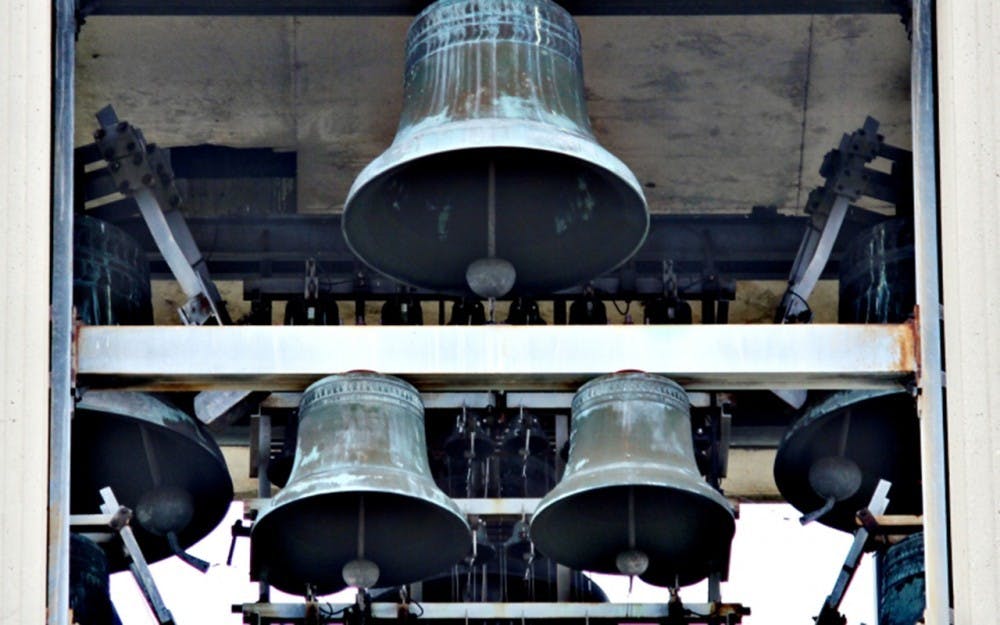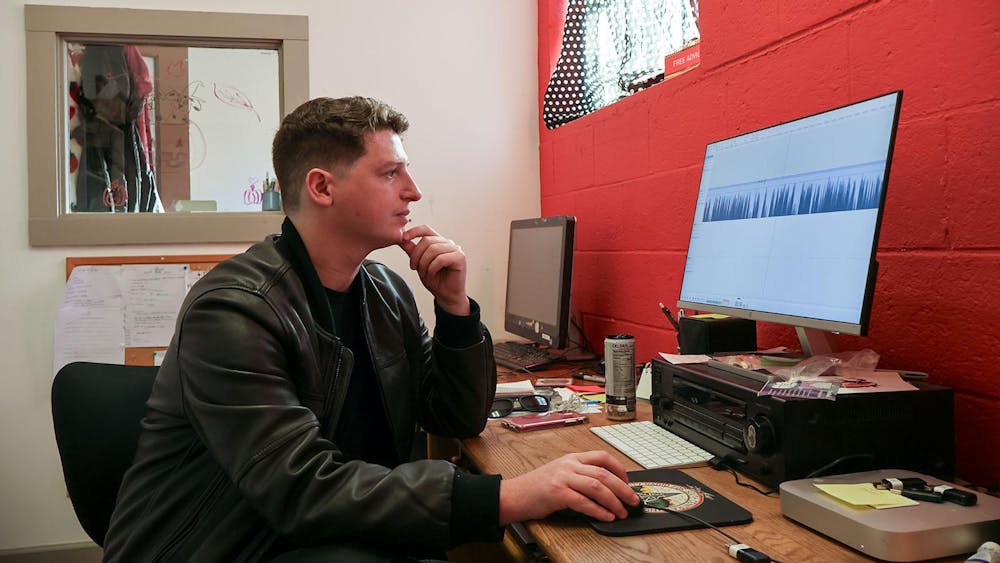The newly constructed Metz Carillon, an instrument made of bells in a tower that cost $7 million, will be rung on Monday in celebration of IU’s bicentennial.
The bell tower encapsulates the features of the IU Bicentennial that will become its legacy: large-scale, expensive construction and publicity organized by university leaders in the face of students’ desire to focus on financial assistance and historical commemoration.
Documents from the university and IU Foundation, the private fundraising arm of IU, seem to validate concerns from students about how IU’s bicentennial initiatives have developed in recent years. Students hoped to learn more about the university’s 200-year history, but instead witnessed relentless institutional and capital expansion efforts, all while the university raised billions of dollars in gifts and reduced its own expenses on student financial aid.
Financial records available online suggest that the IU Bicentennial brought unprecedented growth for the institution’s financial portfolio, including campus infrastructure and new forms of investment such as venture capital, without much to show in direct assistance to students.
Bicentennial programming across various university offices stands in stark contrast to the vision of a history-themed celebration offered by students, faculty, staff and alumni, as several project ideas endorsed by students were apparently abandoned for various reasons.
Students wanted history
A report from the Bicentennial Steering Committee, a group of faculty, staff and students appointed by McRobbie in January 2016, outlines a vision of the IU Bicentennial that seems to have been left behind.
The Steering Committee’s report describes its purpose as helping “establish a common intellectual framework for Indiana University’s Bicentennial, and to identify core principles and values.”
Students wanted the bicentennial to be about history. According to the report, feedback from a survey and focus groups commissioned by the committee found that students “from all campuses” expressed a primary interest in opportunities to introduce historical education to the student body, including in IU course curriculums.
Many of the proposals became “Signature Projects” organized by the Office of the Bicentennial, which is directed by McRobbie’s deputy chief of staff.
One of the student ideas recommended by the committee was a state-wide competition modeled after “The Amazing Race,” a reality television show in which teams follow clues and complete challenges around the world. According to a webpage on the Bicentennial Office’s website, the idea was to involve IU and Bloomington community members in “feats of trivia, athleticism and discovery” around all of IU’s campuses.
Plans for the event have not been announced, and its webpage is not currently linked on the Bicentennial Office’s online list of Signature Projects.
Another idea originally picked up and later shelved was a new museum. According to the Bicentennial Office’s website, the planned IU Museum would “draw from the existing archival holdings of papers, objects, and collections from nearly 200 years of history.” However, the webpage says that “after extensive review and consultation,” the project was put on hold.
To add to the disappointment, a time capsule buried in 1922, which was to be found with the help of student interns and opened this weekend, was eventually located under the parking lot of Kroger in Seminary Square, according to the office. Plans to open it were abandoned because the parking lot is privately owned.
Some proposals that did take root, however, became IU marketing tools.
The Bicentennial Office took up the report’s idea to create a traveling historical exhibit that would visit all of Indiana’s 92 counties. Yet the “Big Red Bus,” as McRobbie called it, is more akin to a marketing campaign on wheels than a small museum.
An interactive virtual tour of the bus shows historical items resting between large crimson-colored panels which boast of IU achievements and follow the bicentennial branding used in IU marketing materials.
“All for You,” the bus campaign, is a slogan echoed on a billboard with the same logo on Interstate 69.
An openly stated objective of the campaign is increasing admissions. "Hopefully the exhibit will inspire people to apply for admission, support university programs or get involved,” Jeremy Hackerd, project manager for the Bicentennial Office, told the Indiana Daily Student in November.
Billions of dollars raised and spent
Meanwhile, financial documents available online show a multi-billion-dollar spending blitz on capital projects, which include building and land purchases, since the announcement of the University’s Bicentennial Strategic Plan in December 2014.
According to university financial audits, annual cash spent on capital and related expenses nearly doubled from Fiscal Year 2014 to its peak in Fiscal Year 2017.
Recent and upcoming projects have had some of the highest price tags of any listed in capital project records available on IU’s Capital Planning and Facilities website. The records date back to July 2007.
The Bicentennial Strategic Plan cites $625 million as the expected cost of renovations intended to be completed this year, much of which uses state funding, according to online budgets.
However, university funding has been used for staggering expenses such as renovations of Memorial Stadium, which cost $53 million, and Wells Quad, which cost $30 million. Building athletics infrastructure and renovating Wells Quad are part of the “action items” in the Bicentennial Strategic Plan.

The large construction projects would not be possible without the Bicentennial Campaign, the primary fundraising campaign of IU Foundation. The foundation says the campaign has raised more than $3 billion.
The trend of expensive capital projects will continue after the bicentennial.
In the works now is a new residence hall with a budget just shy of $100 million, announced alongside hikes in student tuition and fees, which faced the ire of the IDS Editorial Board. A new health sciences building and IU-Purdue University Indianapolis construction have received budgets of $40 million, too.
The Bicentennial Campaign has been a runaway success. Revenue from donor contributions increased 94% after just three years of the campaign entering its public phase in 2015, according to the foundation’s financial audits.
It’s another fundraising victory for McRobbie, who already has one title for “most successful fundraising campaign in university history” under his belt, thanks to a matching campaign that ended in 2010.
At the same time, the university has decreased its annual expenses on student financial aid, university financial documents show.
While the net price of attendance, defined as the cost of attendance remaining after gift aid, has decreased slightly due to new privately endowed scholarships, the amount that the university has opted to spend on financial aid has actually dropped off since the announcement of the Bicentennial Plan.
In other words, the financial records prompt the question of whether current students are paying for the university’s capital spending spree.
The president’s priorities
Class and athletics buildings are only part of the Bicentennial spending story.
This Monday’s events have become so extensive that the university canceled its annual Martin Luther King Jr. Day breakfast and combined MLK Day and Bicentennial events. The Bicentennial festivities will feature several special projects funded at least in part by McRobbie’s little-known resource of discretionary foundation funds, according to an IU Foundation report.
A small group of donors known as the Well House Society contribute unrestricted funds for the president’s discretionary use intended to help the university “meet the greatest need.” More than $27 million dollars of such funds have been raised by the foundation as part of the Bicentennial Campaign.
According to IUF policy, the first priority for all unrestricted donations is given to the president to use at his discretion “to meet extraordinary needs or targets of unusual opportunity of special benefit to the University.” They have been used in the past for emergency scholarships and cultural programs.
According to the foundation, however, McRobbie has used the unrestricted checkbook to fund expensive special projects for the Bicentennial such as restorations of a courtyard outside Maxwell Hall, which is an administrative building, and a large circus carriage with steam whistles, called the IU calliope.
The carillon tower has been the subject of much frustration from students on Twitter and social media platforms, who have lamented the idea that the bell tower has been prioritized over new counselors or functional WiFi.
Even though IU resources are often restricted for certain uses, students have a point. The president’s discretionary funds in particular merit more scrutiny.
The Bicentennial legacy
Building on campus is part of the eight “Bicentennial Priorities” outlined in the Bicentennial Strategic Plan.
Other initiatives attributed to the Bicentennial Priorities include Grand Challenges, a multi-million-dollar program to fund three medical and scientific research projects, and IU Ventures, a new venture capital corporation which business commentators have said could be a “game changer” in the Midwest’s biotechnology startups industry.
A blurb for Grand Challenges ends with a reassurance: “IU will continue to support the creative and scholarly activities of its artists and humanists.”
More reassurance about the university’s priorities will be necessary
McRobbie and IU leadership have turned the Bicentennial into the largest institutional expansion in its recent history. What was once intended to be a celebration of the past with current community members has become, in large part, a capital projects spectacle and marketing opportunity.
The president’s gambit may prove successful in the end, and the investments may pay off for future IU students. Nevertheless, current students, especially the Class of 2020, which was labeled the “Bicentennial Class,” seem right to think they paid for it.
Whatever the legacy of the bicentennial, the IU community should ask: Whom was it all for?
Tom Sweeney (he/him) is a senior studying economics and mathematics. He plans to pursue graduate studies in economics.
CORRECTION: A previous version of this column incorrectly referred to the Metz Carillon tower. It is a carillon tower. The IDS regrets this error.
CORRECTION: A previous version of this column incorrectly referred to the source of funding for the Metz Grand Carillon.






